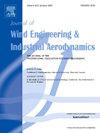Numerical analysis on dynamic airtightness of a high-speed train passing through tunnels based on equivalent leakage coupling
IF 4.9
2区 工程技术
Q1 ENGINEERING, CIVIL
Journal of Wind Engineering and Industrial Aerodynamics
Pub Date : 2025-08-14
DOI:10.1016/j.jweia.2025.106208
引用次数: 0
Abstract
When a high-speed train passes through a tunnel, pressure waves are transferred inside and outside the train through equivalent leakage holes. This study focuses on the flow field coupling of the train's interior and exterior by establishing a numerical model. Using the RNG k-ε turbulence model and sliding mesh approach, numerical simulations are conducted to investigate the dynamic airtightness of the train during tunnel transit. The simulations analyze the effects of equivalent leakage hole parameters and operational environments, including leakage hole area and position, train speed, and tunnel length. The accuracy of the simulation method is validated by comparing results with full-scale tests, demonstrating consistency with theoretical calculations. Results show that the dynamic airtightness index decreases as the leakage hole area increases, indicating an inverse relationship. Pressure variations inside the train are primarily influenced by external pressure near the leakage hole. The greatest airtightness index of 10.82 s occurs when the leakage hole is located at the train's top. The most significant internal pressure changes occur when the train passes through a 110 m tunnel, leading to the lowest dynamic airtightness index. For tunnels longer than 110 m, the dynamic airtightness index stabilizes, with variations remaining below 2 %.
基于等效泄漏耦合的高速列车通过隧道动态气密性数值分析
当高速列车通过隧道时,压力波通过等效的漏孔在列车内外传递。本文通过建立数值模型,对列车内外流场耦合进行了研究。采用RNG k-ε湍流模型和滑动网格法,对列车在隧道通行过程中的动态气密性进行了数值模拟。仿真分析了等效漏孔参数、漏孔面积和位置、列车速度、隧道长度等参数对隧道运行的影响。通过与全尺寸试验结果的比较,验证了仿真方法的准确性,证明了理论计算的一致性。结果表明:随着泄漏孔面积的增大,动态气密性指数减小,呈反比关系;列车内部的压力变化主要受泄漏孔附近的外部压力的影响。泄漏孔位于列车顶部时密封性指数最大,为10.82 s。列车通过110 m隧道时内压变化最大,动态气密性指数最低。对于长度大于110 m的隧道,动态气密性指数趋于稳定,变化幅度保持在2%以下。
本文章由计算机程序翻译,如有差异,请以英文原文为准。
求助全文
约1分钟内获得全文
求助全文
来源期刊
CiteScore
8.90
自引率
22.90%
发文量
306
审稿时长
4.4 months
期刊介绍:
The objective of the journal is to provide a means for the publication and interchange of information, on an international basis, on all those aspects of wind engineering that are included in the activities of the International Association for Wind Engineering http://www.iawe.org/. These are: social and economic impact of wind effects; wind characteristics and structure, local wind environments, wind loads and structural response, diffusion, pollutant dispersion and matter transport, wind effects on building heat loss and ventilation, wind effects on transport systems, aerodynamic aspects of wind energy generation, and codification of wind effects.
Papers on these subjects describing full-scale measurements, wind-tunnel simulation studies, computational or theoretical methods are published, as well as papers dealing with the development of techniques and apparatus for wind engineering experiments.

 求助内容:
求助内容: 应助结果提醒方式:
应助结果提醒方式:


